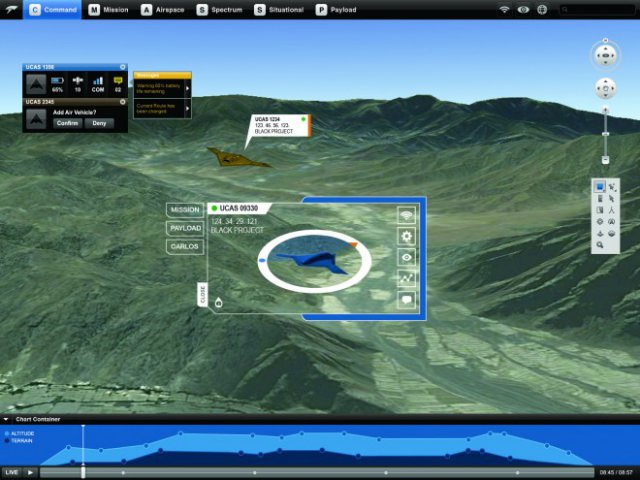 The US military has dozens of different types of UAS and each one has its own unique controller. And each of those various controllers flies a single robot. There’s no system that controls multiple UAS at once. One Pentagon office thinks that’s an archaic way of doing business.
The US military has dozens of different types of UAS and each one has its own unique controller. And each of those various controllers flies a single robot. There’s no system that controls multiple UAS at once. One Pentagon office thinks that’s an archaic way of doing business.
Inside the Pentagon’s Acquisition, Technology and Logistics directorate, a team is working on ways to operate different types of drones with a single controller.
“The objective is to be able to ‘shop’ for mission specific applications and services from a single ‘App Store’,” says Rich Ernst, the Pentagon’s lead officer for what’s called the Unmanned Aerial Systems Control Segment, or UCS, in an emailed statement to Danger Room. “The methodology is akin to the commercial ‘smart-phone’ industry, wherein applications are down-loaded to suit individual user taste and productivity. The repository allows small software businesses to compete on a level playing field” with the major defense conglomerates.
The first such company is California-based DreamHammer. DreamHammer has developed software that can operate numerous robots from the same tablet or laptop. Known as Ballista – it’s a layer that sits on top of the proprietary software governing Predators, Global Hawks, and the rest of the military’s robotic aviary, using application programming interfaces, or APIs.
DreamHammer’s CEO, Nelson Paez, has brought Ballista to Ernst’s attention. Ballista aims to be the first-ever multi-drone operating system — basically, the universal remote. And that would cut through what Paez and Ernst see as an expensive irony. “Currently,” Paez tells Danger Room, “it takes more people to operate unmanned systems than it takes to operate manned systems.”
Paez demonstrated Ballista to me a few weeks ago at a Washington, D.C. restaurant. He wasn’t actually controlling any drones while drinking his coffee. But anyone using Ballista would be able to, using the display loaded onto Paez’s MacBook. The majority of the screen is a 3-D rendered map showing a swath of territory that the drone flies over. Icons show the positioning of the drones, ostensibly in real time via GPS, with color-coded flight paths that a remote pilot can customize. Tabbed browsing shows layers with the mission plan, imagery recorded by the drone, additional aircraft nearby and other relevant data. Switching from one drone to another is a matter of a mouse click.
“Ballista needed the ability to fuse multiple dissimilar data sources (structured or unstructured, real-time or static) from any system into an open, consistent data model,” emails Chris Diebner, DreamHammer’s chief technology officer and one of Ballista’s main designers. Efforts over the course of months by Danger Room to see Ballista in action using Navy drones were unsuccessful.
Ernst declines to talk about Ballista, or any competitors it may have. But whether the solution is Ballista or another piece of software, Ernst’s UCS Architecture, if successful, has the potential to dramatically change robotic warfare.
Full article available at Wired:Danger Room

“Efforts over the course of months by Danger Room to see Ballista in action using Navy drones were unsuccessful” because it DOES NOT. What you saw on the slick salesman’s Macbook was just a simulation. Smoke and mirrors that anyone can create. The DoD is savvy enough to understand there’s no substance behind their flashy marketing material. Do due diligence investigating the company and it becomes very apparent…